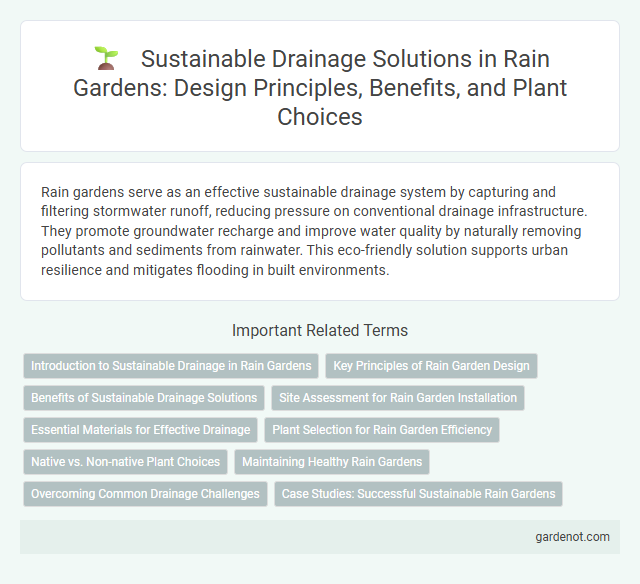Rain gardens serve as an effective sustainable drainage system by capturing and filtering stormwater runoff, reducing pressure on conventional drainage infrastructure. They promote groundwater recharge and improve water quality by naturally removing pollutants and sediments from rainwater. This eco-friendly solution supports urban resilience and mitigates flooding in built environments.
Introduction to Sustainable Drainage in Rain Gardens
Rain gardens function as a key component of Sustainable Drainage Systems (SuDS), designed to manage surface water runoff by mimicking natural hydrological processes. These bio-retention areas use vegetation and soil to filter pollutants, reduce flooding, and promote groundwater recharge. Incorporating rain gardens within urban landscapes supports sustainable water management and enhances biodiversity while mitigating the impact of heavy rainfall events.
Key Principles of Rain Garden Design
Rain gardens are a critical component of sustainable drainage systems, designed to manage stormwater runoff through natural infiltration and evapotranspiration. Key principles of rain garden design include selecting appropriate native vegetation to enhance water absorption, optimizing soil composition to maximize permeability, and positioning the garden strategically to capture runoff from impervious surfaces. Proper sizing based on catchment area and anticipated rainfall events ensures effective flood mitigation and water quality improvement.
Benefits of Sustainable Drainage Solutions
Sustainable drainage solutions in rain gardens effectively manage stormwater by reducing runoff volume and enhancing groundwater recharge. These systems improve water quality by filtering pollutants through native vegetation and soil media, promoting healthier urban ecosystems. Implementing rain gardens contributes to flood mitigation, urban heat island reduction, and increased biodiversity within community landscapes.
Site Assessment for Rain Garden Installation
Site assessment for rain garden installation involves analyzing soil permeability, slope gradient, and existing vegetation to ensure effective water infiltration and retention. Identifying areas with moderate to high rainfall runoff and evaluating underground utilities and drainage patterns optimize rain garden performance within the sustainable drainage system. Proper site assessment mitigates flooding risks and enhances water quality by promoting natural filtration and groundwater recharge.
Essential Materials for Effective Drainage
Sustainable drainage systems (SuDS) rely on essential materials such as permeable soils, gravel layers, and native plants to enhance water infiltration and reduce runoff. These components work together to filter pollutants, promote groundwater recharge, and prevent flooding in rain gardens. Proper selection of materials ensures effective drainage, durability, and environmental benefits in urban landscapes.
Plant Selection for Rain Garden Efficiency
Selecting native, deep-rooted plants with high water uptake enhances rain garden efficiency by improving soil permeability and reducing runoff. Incorporating a mix of grasses, sedges, and flowering perennials optimizes pollutant filtration and supports biodiversity within sustainable drainage systems. Proper plant selection also stabilizes soil, prevents erosion, and promotes faster infiltration in urban stormwater management.
Native vs. Non-native Plant Choices
Native plants in rain gardens play a crucial role in sustainable drainage systems by enhancing water infiltration and supporting local biodiversity. Their deep root systems improve soil structure, reducing runoff and filtering pollutants more effectively than many non-native species. Choosing native plants ensures resilience to local climate conditions and requires less maintenance, making them ideal for long-term sustainable stormwater management.
Maintaining Healthy Rain Gardens
Maintaining healthy rain gardens enhances the effectiveness of sustainable drainage systems by promoting natural water filtration and reducing runoff pollution. Regular removal of debris, monitoring soil moisture, and replacing stressed plants ensure optimal absorption and prevent clogging of infiltration zones. Proper care extends the lifespan of rain gardens and supports urban stormwater management goals.
Overcoming Common Drainage Challenges
Rain gardens serve as a sustainable drainage system by efficiently managing stormwater runoff, reducing surface flooding and soil erosion. They enhance groundwater recharge and filter pollutants through engineered soil layers and native vegetation. Implementing rain gardens addresses common drainage challenges such as poor soil infiltration, surface ponding, and urban runoff contamination.
Case Studies: Successful Sustainable Rain Gardens
Sustainable rain gardens effectively manage stormwater runoff by mimicking natural hydrology, reducing urban flooding and improving water quality. Case studies from Portland, Oregon, and Melbourne, Australia, demonstrate significant decreases in runoff volume and pollutant loads after implementing rain gardens in residential and public spaces. These projects highlight the integration of native vegetation and soil amendments as critical factors for maximizing infiltration and supporting local biodiversity.
Sustainable drainage system Infographic

 gardenot.com
gardenot.com